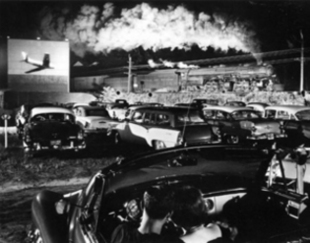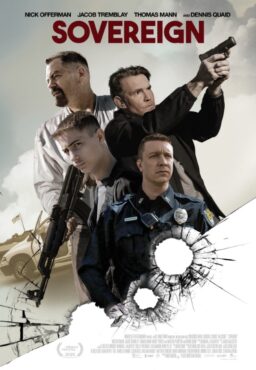It is unthinkable that within a few years, there may be no more new Fords, no more Dodges, no more Chevys to drive to the levee. It is less than a year since the manufacture of Postum was discontinued. Meccano sets are made of plastic. Piece by piece, the American prospect is being dismantled. Will the pulse of teenage boys quicken at the sight of the new Kia or Hyundai? Will they envy their pal because his dad drives a Camaro?
I think that’s all over with. There will be a void in our national imagination. Let me tell you about how it used to be.
In my opinion, the mourner of Miss American Pie drove a Studebaker. It’s simply that “Chevy” was an easier rhyme.

Since the classic 50s Chevy we think of is the ’57 Bel Air, it is reasonable to conclude that the ride of Miss Pie’s friend on the day the music died was a 1957 Studebaker Golden Hawk–the sexiest American car ever manufactured, although there are those who praise the 50s Thunderbirds and Corvettes, however slower than the Hawks they may have been..
But this is not about automobiles. It is about love. They say that when a man reaches 40 and finds some spare change in his pocket, his thoughts turn to the car he desired with all his heart in the years before he got his driver’s license. In 1956, I took a part-time job at Johnston’s Sport Shop in Champaign-Urbana. I was not a stock boy. I was a sales clerk. I knew nothing about sporting goods but I eavesdropped on old Mate Cuppernell, the sunburned, Camel-smoking fishing specialist. Overnight, I was an expert. “These Johnson motors are the same under the skin as the Evinrudes,” I would explain, and, “The big cats are going for these Heddon spinners out at Kaufman’s Clear Lake.”I got an hour for lunch. I stopped first at the Shell station across the street, run by a man who operated juke boxes and sold his old 45s for a nickel apiece. Marty Robbins. Elvis. Then I’d walk a block down Neil Street to the Chuck Wagon diner, one of the first restaurants to feature Col. Harland Sanders’ chicken on its menu. I met him the day they started serving his chicken, and he asked me how I liked his spices. At six, I was given a penny by old Mr. J. C. Penney , so now I had met two titans of marketing.
In between the gas station and the diner was Maxey Motors, a Studebaker-Packard dealer. I didn’t pay it much heed. All I knew about Studebakers was that kids joked about how they looked like they were going in both directions at once. Many years later I discovered that Raymond Loewy’s design for the 1953 Starliner was proclaimed a work of genius by the Museum of Modern Art.
The ’57 Studebaker Golden Hawk. Yes.
But enough about Starliners. One autumn day as I walked bent down into a chill wind, something caught the corner of my eye in the window of Maxey Motors. I turned and stood transfixed. It was the new 1957 Golden Hawk. I forgot the rain. I forgot the chicken. I wanted that car. I walked inside and slowly circled it. My eyes hungered. Before that day, cars were ordinary things like my dad’s boxy ’50 Plymouth or my mom’s ’55 Olds, designed along the lines that made a loaf of bread seem inevitable. Now here was a Hawk! that sprang from a lofty crag and circled the firmament with fierce beauty. And it was supercharged and had a grill that breathed great gulps of air.
The next year I got my driver’s license, and was able to buy a 1954 Ford for $400. I was not faithful to it. In my heart, I lusted for the Golden Hawk. I became expert at sketching it from memory. In profile, the graceful fenders curving down to the headlights, The windshield raked back in harmonious counterbalance. Then the slant of the roof, leading down to the uprising of the bold fins. Musical. You could sing it.
When I was 40, and had a little change in my pocket, my thoughts turned back to the 1957 Golden Hawk. One day I was in Los Angeles and paging through Hemmings Motor News, and found an ad for a ’57 Hawk being restored out in Santa Monica. I went to look at it, and the deal was sealed. Two months later it was dropped off six blocks from my home by an auto carrier. It was gold with white fins and its engine sounded mighty. Driving it home, my left elbow casually on the window sill, I was aware that every male I passed gave it a second look. Not so much the women. Evolution teaches us women are looking for a good provider in a man, not an aesthete. A Volvo driver, not a Hawk driver. Maybe, but the Hawk guy will be more fun in the sack.
The year was 1982. I was a syndicated columnist for the Chicago Sun-Times. I had won a Pulitzer Prize. I was co-host of a national TV show. These credits were pleasing, but…there was something missing. A hollow in my ego, waiting to be filled. I turned the key in the ignition, rolled down the window, turned the radio to rock ‘n roll on an oldies station, hooked my elbow out the window, and purred out of the parking lot. I was only six blocks from home, but somehow my route took me through Old Town, and up and down Rush Street, and slowly through Lincoln Park.
Raymond Lowey: “The father of industrial design”
Out of the corner of my eye I saw males of all ages pausing to stare. They didn’t recognize me, because they weren’t looking at me. They were looking at my car. If they were with women, the women turned to see, not the Hawk, but why their men had paused. Inside of me, intense joy rose. It had nothing do do with what I had accomplished. It was entirely fueled by what I drove. This is a pure joy known to 16-year-old boys from that era, who had nothing else to excite envy except their ride. Even if they were all-state on the football team, it didn’t mean as much if they were driving their dad’s ’40s Oldsmobile.
What pleasure that car gave me. I kept it at our summer place in Michigan. The nearby Red Arrow Highway, the old hard road to Detroit, was built in the 1920s and looked retro. There was a roadhouse used by Capone, with a secret gambling room in the basement. Classic brick Shell stations. Fruit stands. A sign for the annual Milk Bottle Show. There was even a Frank Lloyd Wright lookalike motel. I drove the Golden Hawk around Harbor Country and, reader, I was envied. I frequented Mikey’s in Bridgeman because they had car hops and I could roll down my window to balance a tray with a burger and shake, and Chaz could roll down her window and have her own separate tray. Life was easier in the 1950s.
Searching my old movie reviews for the word Studebaker, I found these words from my review of “Heavy Petting” in 1989:
That autumn I met Chaz. The following summer, we participated in the annual Ride of LaPorte, Indiana. In its simplicity, this is an auto event superior to any other in Indiana, including the Indy 500. What you do is, you park your pre-1960 automobile in a lot at the county fairgrounds, have Coke and hot dogs, and walk around looking at the other cars. I parked my Golden Hawk next to an immaculate 1949 Hudson of the sort Miss Daisy was driven in. Now there was a car. You could raise a family in the back seat. It had the Step-Down Design, which allowed it to wipe out every Ford and Chevy in stock car races. It had less horsepower, but with such a low center of gravity it would cream them on the turns.
At 1 p.m., “The Stars and Stripes Forever” blared from the loudspeakers, and we pulled into line and paraded out of the fairgrounds. A state cop with a whistle was directing traffic onto the street. As we passed her, she said, “Sharp car!”
“Did you hear that?” I asked Chaz.
“Yeah. Sharp car.”
“Sharp car!” I said. “She called it a sharp car!”
“Sharp car, all right,” Chaz said. She later told this story about a thousand times, apparently because it meant something special to her.
With the LaPorte Ride, what you do is, you drive up and down the streets of LaPorte and people sit in lawn chairs and look at you. No floats. No marching bands. No Sheriff Sid on his horse. Just beautiful cars. Mostly the citizens of LaPorte sat and nodded pleasantly, waved a little, and poured their iced tea. But the Golden Hawk was greeted with applause. Perhaps there was a sentimental connection. The Studebaker was manufactured in South Bend, 30 miles away. Some of these people or their relatives may have worked there.
One weekend we took the car on a pilgrimage to South Bend, where I expected to see Studebakers lining the streets and backed up at traffic lights, like in a Twilight Zone episode. No luck. But we drove down by the St. Joseph river, turned right, and there before us was the Studebaker National Museum. We pulled the Hawk into a parking space right next to the entrance, posted, “Studebakers Only.” My license plate read FAUCON, French for hawk.
The Museum occupied what once had been the largest Studebaker dealership in the world. It was across the street from the original Studebaker plant, now standing forlorn. Inside was a visual sea of vehicles. Cars, fire engines, school buses, troop transports, armored cars. The station wagon with the roof that would slide back so you could bring home a totem pole standing upright. The nifty Lark. Taxis. Ambulances. Touring sedans from the 1930s. Classic Packards like Gatsby drove. Champ trucks. Conestoga wagons, because Studebaker was the only wagon-maker that made the transition to cars, The wagons floated down the river to St. Louis, and then were pulled overland into John Wayne movies.
Abraham Lincoln’s Last Ride. (Studebaker National Museum)
They had the carriage built by Studebaker in which Abraham Lincoln drove to Ford’s Theater and did not drive home. The last Packard ever made, a show car for the year Packard died. And lots and lots of Studebakers. And medallions, postcards, t-shirts, visors, books, scarves, hats, jackets, signs, sweat shirts, scale models, books, mugs, jigsaw puzzles, metal Studebaker medallions, belt buckles, cuff links, videos, jigsaw puzzles, key rings and place mats. I discovered the National Studebaker Drivers’ Club is the largest car-owners’ club in America, and I could sign up. If there was one place in the nation that understood the Studebaker, it was South Bend, Indiana. They have a university there, too.
Our guests loved to drive to Mikey’s and get the super-thick shakes. One summer our good friends Gillian and Peter Catto and their children visited from London. He drove a Bentley. I took them for a spin in my Studebaker. I startled them by stepping on the gas.
“Now this is something like it,” he said from the back seat.
“Now tell the story,” Chaz said.
“When these cars were new,” I said. “They were much faster than ’57 Corvettes or T-Birds. The salesmen would put a client on the back seat, put a $100 bill on the front seat, and tell the client he could keep the money if he could overcome the force of the acceleration, and lean forward and pick it up while the Hawk was doing zero-to-60.”

I treasured the Golden Hawk. But I could not give it the care it deserved. I knew nothing about auto mechanics. When it was built, everybody did. When a car stopped and you looked under the hood, you were actually looking for something, not simply performing a roadside pantomime with a car that required computer programmers. I found the honey a good home with Dan Jedlicka, the automobile editor of the Sun-Times, who confessed that he had driven every car in history and the ’57 Hawk was the only one he had wanted to own.
We have come to the end of my story. If Studebaker died in 1966, its legacy lived on in the Avanti, also designed by Raymond Loewy, the century’s greatest industrial designer, who also designed (are you sitting down?) the Coke bottle, the Shell trademark, the Lucky Strike package, and the underlying lines of most of the postwar Studebakers. He could travel from coast to coast by plane, train, automobile and bus, using only vehicles he had designed. Andy Granatelli designed the Avanti engine, and, Wikipedia says, he drove it to establish or break broke 34 U.S. land speed records. So timeless was this sports car, its manufacture was continued until four year ago, and even now plans have been announced to resume production in Cancun.
All of that is sequel. The past is prologue. I fell in love with the Golden Hawk in 1956, I bought one in 1988, and now all I have is a model car on my desk, and my memories. It may be you have a different car in your dreams. If you have turned 40, and have some spare change in your pocket, buy it. It could cost you a fraction of a new car’s price. And if your love is true, that car will be like Benjamin Button, growing younger every year.
Photo at top: “Hot Shot East,” by O. Winston Link. (Collection of Roger and Chaz Ebert
There are a lot of adults around today who will tell you that their peak early sexual experiences took place in cars, and that beds will never be as exciting. Not long ago, for example, I took a woman in her 40s for a drive in my 1957 Studebaker, and after sliding across the vinyl upholstery, inhaling the aroma of gasoline and oil, listening to the tires spinning on the gravel, and waiting for the radio tubes to warm up, she reported that all of these physical associations made her feel exactly as if someone was going to try to take off her bra.















